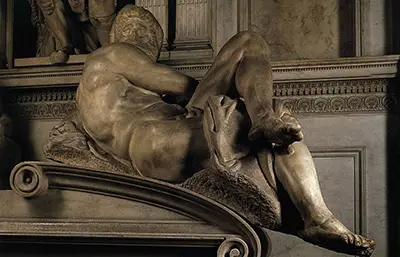The idea of a day, it's beginning and ending and what can be accomplished during that time, has always seemed to fascinate people in different cultures.
Each new day is filled with promise and that seems to be symbolised by the figure in the set which is often referred to as Dawn. This particular sculpture sharply marks the section of a day where things are just beginning and lots of rewards may be had for the man or woman who can, as the popular saying goes, seize the day with both hands.
Michelangelo used marble for Day, Dawn, Dusk and Night. The hardness of the material indicates that whatever is to be obtained from each day must be gained with a certain amount of struggle. Indeed, that cannot be avoided and it seems that even the contemplative expressions of the statues echo this fact. For those who rise each morning prepared to overcome the challenges that arise, the possibilities are endless. Marble is not the easiest medium to work with and yet, Michelangelo enjoyed exploring its facets.
The artist often chose to leave certain sections of his sculptures unfinished. This helped to draw attention to the fact that the work of art that had been painstakingly cut from the marble was produced with a significant mount of effort. He chose to do this with one of the figures in this set. Doing so also brings attention to his topic since it seems like the figure is fighting through the marble.
Michelangelo did extensive work on the sarcophagus of Lorenzo de Medici, who was the Duke of Urbino, from 1520 to 1534. In the meantime he also dealt with all artwork related to the tomb of his brother, Giuliano de Medici. Michelangelo was in an interesting position.
Even though the Medici family sponsored much of his work, he was not in favour of having them rule Florence. Some of the art that he completed for them actually speaks against their government and yet, those sculptures are a part of the family's legacy. Pieces which speak against them are viewed every day by visitors to the Medici Chapel and their tombs.
Medici Chapel was the sanctuary to individuals from the Medici family. It is currently located in the New Sacristy and is also known as the Cappella Medicea. Visitors to the Church of San Lorenzo in Florence may enjoy Michelangelo's work there. The Medici Chapel is a place that Michelangelo fans who journey to Florence may want to consider visiting.
Day and the other sculptures on the topic are placed at the feet of the Medici brothers. A pair are at the feet of Lorenzo de Medici. They are in front of his tomb. The second funerary landmark is to Giuliano de Medici. He was the most youthful child of Lorenzo the Magnificent and sibling of Giovanni de Medici, who incidentally, was Pope Leo X.
These statues speaking to Giuliano and Lorenzo II which are placed beside the Day series were not practical portrayals of the genuine men. Rather, they were implied as metaphorical figures. Giuliano, who is holding the mallet of an armed force authority, depicts the dynamic man. At his feet lean back the figures of Night and Day.
Night is portrayed as a giantess and is one of the few female sculptures completed by Michelangelo. Night is curving in uneasy sleep and it seems that the artist may be making a political statement here. Perhaps he thinks the Medici has not earned a peaceful, uninterrupted rest. If Night is taken as a stage of life, perhaps that of eternal rest, Michelangelo may be indicting that the Medici should be uneasy for eternity.
Day is portrayed as a Herculean figure, looks fiercely behind him. In a modern context, this my be interpreted by some as Day having to watch his back. Instead of looking ahead to the future with hope, he is bound to spend his time looking over his shoulder. Similarly as powerful, however far less rough, are the two sidekick figures leaning back on the sarcophagus of Lorenzo. The male figure is known as representing the Dusk. This my be the dusk of life. The female figure represents the sunrise.
Day is not presented as a hopeful figure. Unlike Night, which has features which are clearly carved in marble, Michelangelo has given this figure an eerie demeanor. He has chosen to do this by embracing an incomplete surface for his face. This makes Day's head stand out from the very clean and polished surface of whatever remains of his body. Seen through a shroud of marble, Day's tormented expression goes up with a frightful essence.
The solid improvement of Day outperformed even the undulating may of David or Moses, yet the figure seems to become fatigued from the mass of his own body, reverberating with the drained discouragement found in the models of the dukes. Evidently, ruling the way that Medicis had is not rewarding in the long term. It has a draining effect on the spirit. Even though the sculptures are toned, presumably reflecting good food and other aspects of physical wellness, the face of Day seems to say that the lifestyle is associated with turmoil not true happiness.


